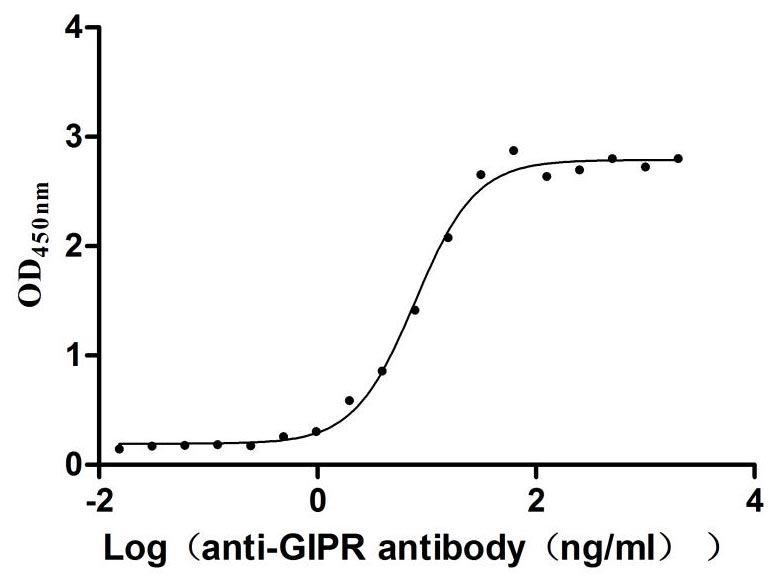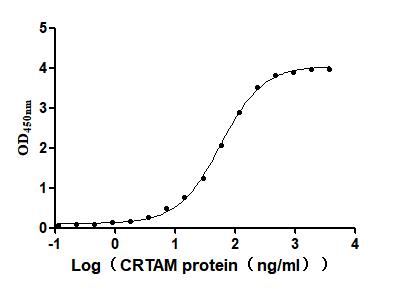Recombinant Human Cyclin-F (CCNF)
-
中文名稱:Recombinant Human Cyclin-F(CCNF),Yeast
-
貨號:CSB-YP004819HU
-
規(guī)格:
-
來源:Yeast
-
其他:
-
中文名稱:Recombinant Human Cyclin-F(CCNF),Yeast
-
貨號:CSB-EP004819HU
-
規(guī)格:
-
來源:E.coli
-
其他:
-
中文名稱:Recombinant Human Cyclin-F(CCNF),Yeast
-
貨號:CSB-EP004819HU-B
-
規(guī)格:
-
來源:E.coli
-
共軛:Avi-tag Biotinylated
E. coli biotin ligase (BirA) is highly specific in covalently attaching biotin to the 15 amino acid AviTag peptide. This recombinant protein was biotinylated in vivo by AviTag-BirA technology, which method is BriA catalyzes amide linkage between the biotin and the specific lysine of the AviTag.
-
其他:
-
中文名稱:Recombinant Human Cyclin-F(CCNF),Yeast
-
貨號:CSB-BP004819HU
-
規(guī)格:
-
來源:Baculovirus
-
其他:
-
中文名稱:Recombinant Human Cyclin-F(CCNF),Yeast
-
貨號:CSB-MP004819HU
-
規(guī)格:
-
來源:Mammalian cell
-
其他:
產(chǎn)品詳情
-
純度:>85% (SDS-PAGE)
-
基因名:CCNF
-
Uniprot No.:
-
別名:Ccnf; CCNF_HUMAN; Cyclin-F; F box only protein 1; F-box only protein 1; FBX1; FBXO1; G2 mitotic specific cyclin F; G2/mitotic specific cyclin F
-
種屬:Homo sapiens (Human)
-
蛋白長度:Full length protein
-
表達(dá)區(qū)域:1-786
-
氨基酸序列MGSGGVVHCR CAKCFCYPTK RRIRRRPRNL TILSLPEDVL FHILKWLSVE DILAVRAVHS QLKDLVDNHA SVWACASFQE LWPSPGNLKL FERAAEKGNF EAAVKLGIAY LYNEGLSVSD EARAEVNGLK ASRFFSLAER LNVGAAPFIW LFIRPPWSVS GSCCKAVVHE SLRAECQLQR THKASILHCL GRVLSLFEDE EKQQQAHDLF EEAAHQGCLT SSYLLWESDR RTDVSDPGRC LHSFRKLRDY AAKGCWEAQL SLAKACANAN QLGLEVRASS EIVCQLFQAS QAVSKQQVFS VQKGLNDTMR YILIDWLVEV ATMKDFTSLC LHLTVECVDR YLRRRLVPRY RLQLLGIACM VICTRFISKE ILTIREAVWL TDNTYKYEDL VRMMGEIVSA LEGKIRVPTV VDYKEVLLTL VPVELRTQHL CSFLCELSLL HTSLSAYAPA RLAAAALLLA RLTHGQTQPW TTQLWDLTGF SYEDLIPCVL SLHKKCFHDD APKDYRQVSL TAVKQRFEDK RYGEISQEEV LSYSQLCAAL GVTQDSPDPP TFLSTGEIHA FLSSPSGRRT KRKRENSLQE DRGSFVTTPT AELSSQEETL LGSFLDWSLD CCSGYEGDQE SEGEKEGDVT APSGILDVTV VYLNPEQHCC QESSDEEACP EDKGPQDPQA LALDTQIPAT PGPKPLVRTS REPGKDVTTS GYSSVSTASP TSSVDGGLGA LPQPTSVLSL DSDSHTQPCH HQARKSCLQC RPPSPPESSV PQQQVKRINL CIHSEEEDMN LGLVRL
-
蛋白標(biāo)簽:Tag?type?will?be?determined?during?the?manufacturing?process.
The tag type will be determined during production process. If you have specified tag type, please tell us and we will develop the specified tag preferentially. -
產(chǎn)品提供形式:Lyophilized powder
Note: We will preferentially ship the format that we have in stock, however, if you have any special requirement for the format, please remark your requirement when placing the order, we will prepare according to your demand. -
復(fù)溶:We recommend that this vial be briefly centrifuged prior to opening to bring the contents to the bottom. Please reconstitute protein in deionized sterile water to a concentration of 0.1-1.0 mg/mL.We recommend to add 5-50% of glycerol (final concentration) and aliquot for long-term storage at -20℃/-80℃. Our default final concentration of glycerol is 50%. Customers could use it as reference.
-
儲存條件:Store at -20°C/-80°C upon receipt, aliquoting is necessary for mutiple use. Avoid repeated freeze-thaw cycles.
-
保質(zhì)期:The shelf life is related to many factors, storage state, buffer ingredients, storage temperature and the stability of the protein itself.
Generally, the shelf life of liquid form is 6 months at -20°C/-80°C. The shelf life of lyophilized form is 12 months at -20°C/-80°C. -
貨期:Delivery time may differ from different purchasing way or location, please kindly consult your local distributors for specific delivery time.Note: All of our proteins are default shipped with normal blue ice packs, if you request to ship with dry ice, please communicate with us in advance and extra fees will be charged.
-
注意事項(xiàng):Repeated freezing and thawing is not recommended. Store working aliquots at 4°C for up to one week.
-
Datasheet :Please contact us to get it.
相關(guān)產(chǎn)品
靶點(diǎn)詳情
-
功能:Substrate recognition component of a SCF (SKP1-CUL1-F-box protein) E3 ubiquitin-protein ligase complex which mediates the ubiquitination and subsequent proteasomal degradation of target proteins. The SCF(CCNF) E3 ubiquitin-protein ligase complex is an integral component of the ubiquitin proteasome system (UPS) and links proteasome degradation to the cell cycle. Mediates the substrate recognition and the proteasomal degradation of various target proteins involved in the regulation of cell cycle progression and in the maintenance of genome stability. Mediates the ubiquitination and proteasomal degradation of CP110 during G2 phase, thereby acting as an inhibitor of centrosome reduplication. In G2, mediates the ubiquitination and subsequent degradation of ribonucleotide reductase RRM2, thereby maintaining a balanced pool of dNTPs and genome integrity. In G2, mediates the ubiquitination and proteasomal degradation of CDC6, thereby suppressing DNA re-replication and preventing genome instability. Involved in the ubiquitination and degradation of the substrate adapter CDH1 of the anaphase-promoting complex (APC/C), thereby acting as an antagonist of APC/C in regulating G1 progression and S phase entry. May play a role in the G2 cell cycle checkpoint control after DNA damage, possibly by promoting the ubiquitination of MYBL2/BMYB.
-
基因功能參考文獻(xiàn):
- A single missense mutation in cyclin F causes hyper-ubiquitylation of proteins that can indirectly impair the autophagy degradation pathway, which is implicated in amyotrophic lateral sclerosis pathogenesis. PMID: 28852778
- Cyclin F and ribonucleotide reductase family member 2 (RRM2) compose a functional axis responsible for nucleotide metabolism. Impairment in this pathway may contribute to increased DNA damage repair and drug resistance. Additionally, we analyzed the expression of RRM2 mRNA and discovered that high expression of RRM2 is associated with worse overall survival. PMID: 29767233
- Mutational spectrum of CCNF emphasizes the pathogenic role of CCNF mutations in ALS. PMID: 29102476
- Our result indicates that the mutation of CCNF is rare in patients with amyotrophic lateral sclerosis and frontotemporal dementia from Mainland China PMID: 28281833
- These data indicate that the coordinated, temporal ordering of cyclin F and Cdh1 degradation, organized in a double-negative feedback loop, represents a fundamental aspect of cell-cycle control PMID: 27653696
- Authors demonstrated a significant correlation between the severity of the CCNF-induced axonopathy and a reduced motor response to a light stimulus (photomotor response). PMID: 28444311
- Cyclin F-mediated degradation of SLBP limits H2A.X accumulation and apoptosis upon genotoxic stress in G2 cell cycle checkpoint. PMID: 27773672
- cyclin F is a novel F-box protein that functions as an intrinsic cellular regulator of HIV-1 Vif and has a negative regulatory effect on the maintenance of viral infectivity by restoring APOBEC3G expression PMID: 28184007
- The SCYL1- BP1 affects the cell cycle through increasing steady state levels of Cyclin F and RRM2 proteins, thus constituting a dual regulatory circuit. PMID: 25980818
- Data indicate that a missense mutation in cyclin F (CCNF) in a large Amyotrophic lateral sclerosis (ALS) and frontotemporal dementia (FTD) family. PMID: 27080313
- CDC6 and Cyclin F interact through defined sequence motifs that promote CDC6 ubiquitylation and degradation. PMID: 26818844
- Cyclin F suppresses B-Myb activity to promote cell cycle checkpoint control. PMID: 25557911
- Cyclin F controls genome stability through ubiquitin-mediated proteolysis. (Review) PMID: 23182110
- After DNA damage, cyclin F is downregulated in an ATR-dependent manner to allow accumulation of RRM2. Defective elimination of cyclin F delays DNA repair and sensitizes cells to DNA damage, a phenotype that is reverted by expressing a nondegradable RRM2 mutant. PMID: 22632967
- SCF(Cyclin F)-mediated degradation of CP110 is required for the fidelity of mitosis and genome integrity PMID: 20596027
- degradation during G2-M by mechanisms fundamentally different from other cyclins PMID: 12122006
顯示更多
收起更多
-
亞細(xì)胞定位:Nucleus. Cytoplasm, perinuclear region. Cytoplasm, cytoskeleton, microtubule organizing center, centrosome, centriole.
-
蛋白家族:Cyclin family, Cyclin AB subfamily
-
組織特異性:Widely expressed, with expression detected in the heart, brain, placenta, lung, liver, skeletal muscle, kidney and pancreas.
-
數(shù)據(jù)庫鏈接:
Most popular with customers
-
Recombinant Human Secreted and transmembrane protein 1 (SECTM1), partial (Active)
Express system: Mammalian cell
Species: Homo sapiens (Human)
-
Recombinant Human T-cell surface protein tactile (CD96), partial (Active)
Express system: Mammalian cell
Species: Homo sapiens (Human)
-
Recombinant Human HLA class II histocompatibility antigen gamma chain (CD74), partial (Active)
Express system: Mammalian cell
Species: Homo sapiens (Human)
-
Recombinant Human IGF-like family receptor 1 (IGFLR1), partial (Active)
Express system: Mammalian cell
Species: Homo sapiens (Human)
-
Recombinant Macaca mulatta Microtubule-associated protein tau (MAPT) (Active)
Express system: Mammalian cell
Species: Macaca mulatta (Rhesus macaque)
-
Recombinant Macaca fascicularis lymphocyte antigen 6 family member G6D (LY6G6D) (Active)
Express system: Yeast
Species: Macaca fascicularis (Crab-eating macaque) (Cynomolgus monkey)
-
Recombinant Rat Gastric inhibitory polypeptide receptor (Gipr), partial (Active)
Express system: Mammalian cell
Species: Rattus norvegicus (Rat)
-
Recombinant Mouse Cytotoxic and regulatory T-cell molecule (Crtam), partial (Active)
Express system: Mammalian cell
Species: Mus musculus (Mouse)



-AC1.jpg)
-AC1.jpg)















